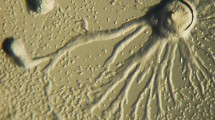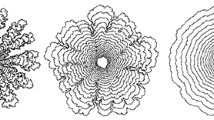Abstract
The decentralised gathering problem consists in grouping in a compact cluster agents that are initially randomly scattered. We propose a bio-inspired algorithm, the Reaction–Diffusion–Chemotaxis aggregation scheme, to group agents that have limited abilities. The agents and their environment are described with a stochastic model inspired by the aggregation of the Dictyostelium discoideum cellular slime mold. The environment is an active lattice, whose cells transmit information according to a reaction–diffusion mechanism. The agents are virtual amoebae; they trigger excitations randomly and move by following reaction–diffusion waves. We demonstrate that despite its simplicity, this model exhibits interesting properties of self-organisation and is efficient for gathering agents. Moreover, observations show that the system is robust to various perturbations, such as the presence of obstacles on the lattice or noise in the movements of the agents.
Similar content being viewed by others
References
Abelson, H., Allen, D., Coore, D., Hanson, C., Homsy, G., Thomas, F., Knight, J., Nagpal, R., Rauch, E., Sussman, G. J., & Weiss, R. (2000). Amorphous computing. Communications of ACM (Association for Computing Machinery), 43(5), 74–82.
Adamatzky, A. (2001). Computing in nonlinear media and automata collectives. Bristol: Institute of Physics.
Agarwal, P. (1994). Simulation of aggregation in Dictyostelium using the cell programming language. Computer Applications Biosciences, 10(6), 647–655.
Ando, H., Oasa, Y., Suzuki, I., & Yamashita, M. (1999). Distributed memoryless point convergence algorithm for mobile robots with limited visibility. IEEE Transactions on Robotics and Automation, 15(5), 818–828.
Bretschneider, T., Vasiev, B., & Weijer, C. J. (1997). A model for cell movement during Dictyostelium mound formation. Journal of Theoretical Biology, 189(1), 41–51.
Chevrier, V., & Fatès, N. (2008). Multi-agent systems as discrete dynamical systems: influences and reactions as a modelling principle (Tech. rep.). INRIA–LORIA, Nancy, France, http://hal.inria.fr/inria-00345954.
Christensen, A. L., O’Grady, R., & Dorigo, M. (2008). SWARMORPH-script: a language for arbitrary morphology generation in self-assembling robots. Swarm Intelligence, 2(2–4): 143–165.
Dallon, J. C., & Othmer, H. G. (1997). A discrete cell model with adaptive signalling for aggregation of Dictyostelium discoideum. Philosophical Transactions of the Royal Society B, 352, 391–417.
Deutsch, A., & Dormann, S. (2005). Cellular automaton modeling of biological pattern formation characterization, applications, and analysis. Modeling and simulation in science, engineering and technology. Hingham: Kluwer Academic.
DeYoung, G., Monk, P. B., & Othmer, H. G. (1988). Pacemakers in aggregation fields of Dictyostelium discoideum: does a single cell suffice? Journal of Mathematical Biology, 26(5), 487–517.
Dorigo, M., & Stützle, T. (2004). Ant colony optimization. Cambridge: MIT Press.
Fatès, N. (2009). Asynchronism induces second order phase transitions in elementary cellular automata. Journal of Cellular Automata, 4(1), 21–38.
Fatès, N., & Berry, H. (2010). Robustness of the critical behaviour in a discrete stochastic reaction-diffusion medium. In Peper, F., et al. (Eds.), Proceedings in information and communications technology: Vol. 2. Proceedings of the IWNC 2009 (pp. 141–148). Berlin: Springer.
Fatès, N., & Morvan, M. (2004). Perturbing the topology of the game of life increases its robustness to asynchrony. In Sloot, P. M. A., Chopard, B., & Hoekstra, A. G. (Eds.), LNCS: Vol. 3305. Proceedings of the 6th international conference on cellular automata for research and industry (pp. 111–120). Berlin: Springer.
Fatès, N, & Morvan, M. (2005). An experimental study of robustness to asynchronism for elementary cellular automata. Complex Systems, 16, 1–27.
Flocchini, P., Prencipe, G., Santoro, N., & Widmayer, P. (2005). Gathering of asynchronous robots with limited visibility. Theoretical Computer Science, 337(1–3), 147–168.
Garnier, S., Jost, C., Gautrais, J., Asadpour, M., Caprari, G., Jeanson, R., Grimal, A., & Theraulaz, G. (2008). The embodiment of cockroach aggregation behavior in a group of micro-robots. Artificial Life, 14(4), 387–408.
Garnier, S., Gautrais, J., Asadpour, M., Jost, C., & Theraulaz, G. (2009). Self-organized aggregation triggers collective decision making in a group of cockroach-like robots. Adaptive Behavior, 17(2), 109–133.
Geberth, D., & Hütt, M. T. (2008). Predicting spiral wave patterns from cell properties in a model of biological self-organization. Physical Review E, 78(3), 031917.
Geberth, D., & Hütt, M. T. (2009). Predicting the distribution of spiral waves from cell properties in a developmental-path model of Dictyostelium pattern formation. PLoS Computatinal Biology, 5(7), e1000422.
Girau, B., Torres-Huitzil, C., Vlassopoulos, N., & Barron-Zambrano, H. (2009, to appear). Reaction–diffusion and chemotaxis for decentralized gathering on FPGAs. International Journal on Reconfigurable Computing.
Greenberg, J. M., Hassard, B. D., & Hastings, S. P. (1978). Pattern formation and periodic structures in systems modeled by reaction–diffusion equations. Bulletin of the American Mathematical Society, 84(6), 1296–1327.
Hillen, T., & Painter, K. J. (2009). A user’s guide to pde models for chemotaxis. Journal of Mathematical Biology, 58, 183–217.
Hinrichsen, H. (2000). Nonequilibrium critical phenomena and phase transitions into absorbing states. Advances in Physics, 49, 815–958.
Kapral, R. (1991). Discrete models for chemically reacting systems. Journal of Mathematical Chemistry, 6(1), 113–163.
Keller, E. F., & Segel, L. A. (1971). Travelling bands of chemotactic bacteria: a theoretical analysis. Journal of Theoretical Biology, 30(2), 235–248.
Markus, M., & Hess, B. (1990). Isotropic cellular automaton for modelling excitable media. Nature, 347, 56–58.
Nagano, S. (2000). Modeling the model organism Dictyostelium discoideum. Development Growth and Differentiation, 42(6), 541–550.
Newman, T. J., & Grima, R. (2004). Many-body theory of chemotactic cell-cell interactions. Physical Review E, 70(5), 051916.
Othmer, H. G., & Stevens, A. (1997). Aggregation, blowup, and collapse: the abc’s of taxis in reinforced random walks. SIAM Journal of Applied Mathematics, 57(4), 1044–1081.
Prencipe, G. (2007). Impossibility of gathering by a set of autonomous mobile robots. Theoretical Computer Science, 384(2–3), 222–231.
Sepulchre, J. A., & Babloyantz, A. (1991). Propagation of target waves in the presence of obstacles. Physical Review Letters, 66(10), 1314–1317.
Sepulchre, J. A., & Babloyantz, A. (1993). Motions of spiral waves in oscillatory media and in the presence of obstacles. Physical Review E, 48(1), 187–195.
Simpson, M. J., Merrifield, A., Landman, K. A., & Hughes, B. D. (2007). Simulating invasion with cellular automata: Connecting cell-scale and population-scale properties. Physical Review E, 76(2), 021918.
Smith, A. R. (1971). Two-dimensional formal languages and pattern recognition by cellular automata. In Proceedings of the annual IEEE symposium on foundations of computer science (pp. 144–152). Los Alamitos: IEEE Computer Society.
Spicher, A., Fatès, N., & Simonin, O. (2010). Translating discrete multi-agents systems into cellular automata: application to diffusion-limited aggregation. In Filipe, J., Fred, A., & Sharp, B. (Eds.), CCIS: Vol. 67. Proceedings of ICAART’09—revised selected papers (pp. 270–282). Berlin: Springer. http://www.springer.com/computer/artificial/book/978-3-642-11818-0.
Sugihara, K., & Suzuki, I. (1990). Distributed motion coordination of multiple mobile robots. In Proceedings of 5th IEEE international symposium on intelligent control (pp. 138–143).
Turing, A. M. (1952). The chemical basis of morphogenesis. Philosophical Transactions of the Royal Society of London B, 237, 37–72.
Vasieva, O. O., Vasiev, B. N., Karpov, V. A., & Zaikin, A. (1994). A model of Dictyostelium discoideum aggregation. Journal of Theoretical Biology, 171(4), 361–367.
Author information
Authors and Affiliations
Corresponding author
Additional information
Research supported by the ARC AMYBIA grant by the INRIA institute.
Electronic Supplementary Material
Below is the link to the electronic supplementary material.
Rights and permissions
About this article
Cite this article
Fatès, N. Solving the decentralised gathering problem with a reaction–diffusion–chemotaxis scheme. Swarm Intell 4, 91–115 (2010). https://doi.org/10.1007/s11721-010-0038-4
Received:
Accepted:
Published:
Issue Date:
DOI: https://doi.org/10.1007/s11721-010-0038-4




